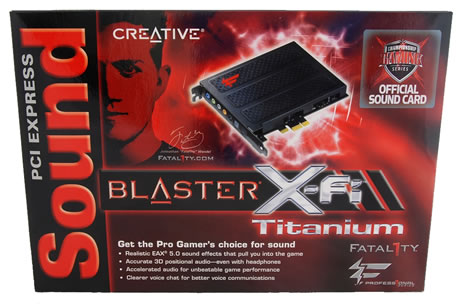Creative has been a leader in the PC audio market for as long as I can remember. In fact, the first Sound Blaster card hit the market almost 20 years ago, which can be considered an eternity in "computer years".
During this time, Creative has launched about a dozen major soundcards, with their latest outgoing product being the Sound Blaster X-Fi series, which replaced the popular Audigy line a few years ago.
The X-Fi Titanium Fatal1ty Pro that we are testing today is Creative's latest offering in the series, making use of a slightly modified chip called EMU20K2 that adds native PCI Express support among a number of improvements and fixes over the previous generation of cards.
Aimed at audio enthusiasts and especially gamers, Creative offers two versions of the X-Fi Titanium Fatal1ty Pro. The one we are testing that could be considered the lite version of the package that includes mainly the soundcard, while a more expensive version adds a 5 ¼" I/O drive similar to the ones Creative has offered in the past. Other than the added module, a remote control, and the extra $50, the two products are identical.

Out of the Box
Opening the box doesn't reveal a whole lot. The bundle of this $130 soundcard is scarce and consists of just a quick start guide, the drivers disc, and the card itself.
As mentioned above, one of the first things you will notice about the X-Fi Titanium Fatal1ty is that it uses a PCI Express x1 interface. If you don't have a x1 slot on your motherboard or don't have access to one (due to an oversized video card cooler, for example) you can always install the card in a larger slot, be it x8 or x16.

Besides the PCI Express interface, the card is very unique looking because of the cover that goes over the entire card. Upon first glance, this looks like a large heatsink covering all components, but in reality Creative added the cover for the visual effect that it creates and as a foundation to add the Fatal1ty and X-Fi logos, the latter of which lights up with a white LED when the computer is running. The cover is also used as a shield to protect the delicate capacitors that litter the card's surface.
On the back of the card we have the standard array of audio connections, including the line-in jack and four speaker-out jacks compatible with 2.1, 5.1 and 7.1 speaker systems. Also present are optical in/optical out connections that can be used for things such as gaming consoles and AV receivers, respectively.

Hardware installation went without issues as expected. I chose to install the X-Fi Titanium in a PCI Express x1 slot as I had one readily available. Software installation, on the other hand, was a bit more involved. Be prepared for this process to take a long time and require a few restarts. Also worth nothing, I experienced a blue screen of death (a.k.a. BSOD) during my initial install and had to start all over again.
This only happened once, after which I was able to successfully install the card's drivers and software. At this point it was made obvious to us that Creative has not made striding efforts to improve a nagging software installation that dates back to the days of the SB Live.
Creative includes an impressive software bundle with the X-Fi Titanium composed of lots of in-house utilities plus PowerDVD. For brevity, I will briefly cover the more relevant software and point out key features along the way in the next page.